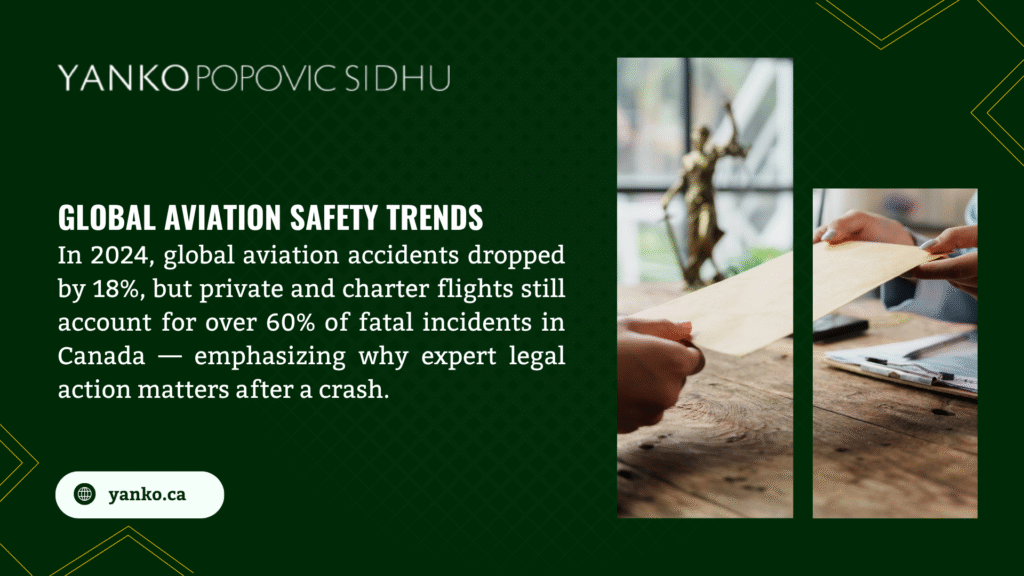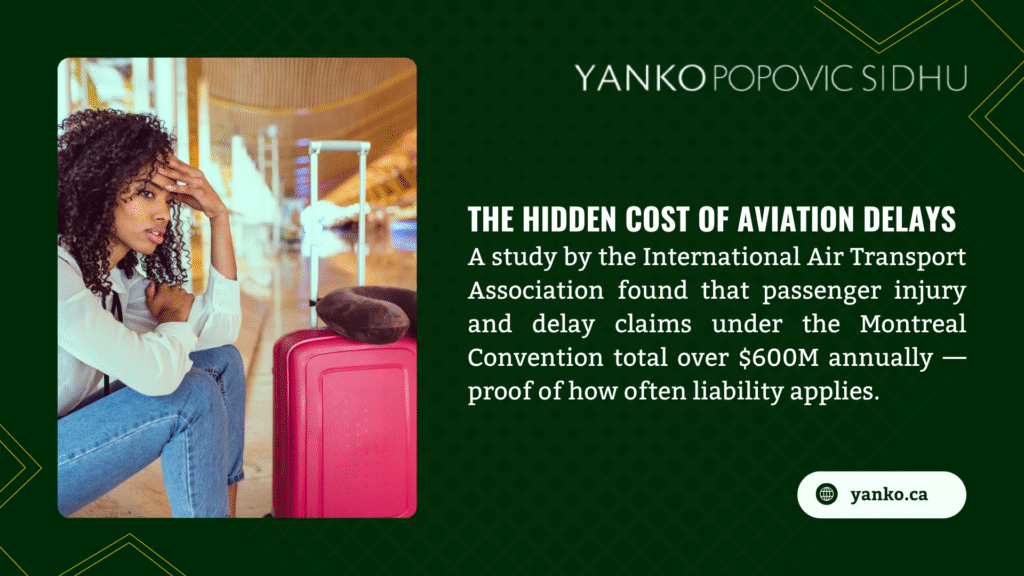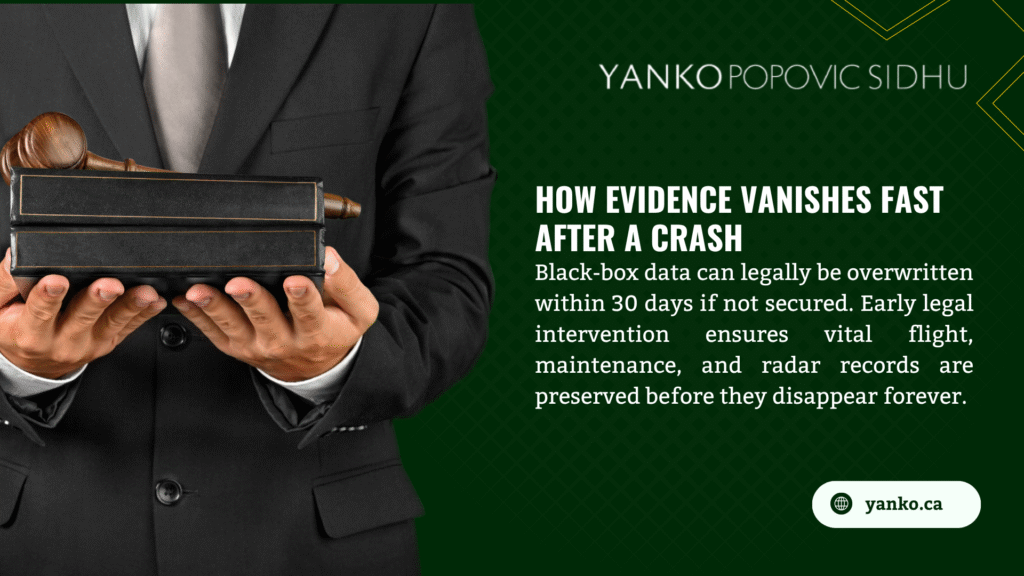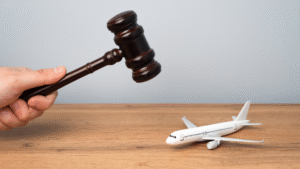With over 40 years of personal injury experience in Alberta, David Yanko has represented more than 10,000 injury victims, securing millions in compensation.
Article Summary
| Topic | What You’ll Learn |
| Definition | What does an aviation accident settlement cover under Alberta and Canadian law |
| Applicable Law | When the Montreal Convention and Carriage by Air Act apply vs when Alberta tort law governs |
| Eligibility | Who can pursue compensation, and what rights do families have |
| Damages | What compensation includes: medical, loss of income, and wrongful-death damages |
| Process | The step-by-step path from investigation to settlement |
| Time Limits | Why Alberta’s Limitations Act two-year window is critical |
| Typical Settlement Values | How courts and insurers calculate plane crash settlement amounts |
| Mistakes | Common errors that reduce payouts |
| Role of a Lawyer | How a specialized aviation lawyer builds a stronger claim |
| Next Step | How to start your aviation accident settlement with Yanko Popovic Sidhu |
Aviation accident settlements in Alberta exist to compensate people injured or killed in aircraft crashes or aviation-related incidents. Whether the flight was international or domestic, victims and their families may claim compensation for medical costs, lost income, pain and suffering, and bereavement under Alberta’s Fatal Accidents Act. These settlements can reach hundreds of thousands or even millions, depending on fault, insurance, and evidence. Acting within Alberta’s two-year limitation period is vital, and having an experienced aviation accident lawyer in Calgary ensures every liable party is held accountable and your compensation reflects the true impact of your loss.
What an Aviation Accident Settlement Means in Alberta
When an aircraft accident occurs, whether it involves a commercial airline, helicopter, charter jet, or private plane, the injured passenger or the victim’s family may pursue an aviation accident settlement. In simple terms, this is a financial resolution for losses suffered because of negligence or wrongful actions tied to the operation or maintenance of an aircraft.
In Alberta, aviation cases follow either federal aviation laws or provincial negligence laws, depending on where and how the incident happened. If the flight was international, the Montreal Convention (1999), enacted in Canada through the Carriage by Air Act, dictates the airline’s liability. If the crash or injury occurred on a domestic flight within Canada, Alberta’s civil liability framework applies, and compensation follows traditional tort principles.
From my experience as a Calgary lawyer, the difference between these two legal routes determines how much a victim or their family may receive. For international flights, there are defined liability caps; for domestic flights, there are none, only the strength of your evidence and damage proof.
Liability Framework: Who Pays in an Aviation Accident Settlement
When I handle aviation accident settlement cases, I start by identifying every potentially liable party. Aviation accidents rarely involve a single point of failure. Alberta courts allow joint and several liability, meaning several defendants can share the obligation to pay damages.
| Party | Legal Basis for Liability | Example Evidence Reviewed |
| Airline / Air Carrier | Duty to operate safely and ensure crew competence under the Carriage by Air Act and the Montreal Convention | Crew logs, flight-data recorders, maintenance schedules |
| Aircraft Owner / Operator | Responsibility for mechanical safety and hiring competent personnel | Lease contracts, inspection history |
| Maintenance / Repair Company | Negligent service or use of defective parts | Work orders, manufacturer bulletins |
| Aircraft / Parts Manufacturer | Design or production defects create risk | Technical drawings, recall reports |
| Airport / Ground Crew | Runway or fueling negligence leading to damage | Duty logs, surveillance video |
| Air Traffic Control / NAV CANADA | Communication or routing error | Radar and voice transcripts |
Each of these sources can contribute to the final aviation accident settlement value. When more than one party is proven negligent, the settlement can grow significantly because multiple insurers become responsible for payment.
Governing Laws: Alberta vs International Regimes
| Flight Type | Law That Applies | Practical Effect on Settlement |
| International | Montreal Convention (1999) under Canada’s Carriage by Air Act | Creates strict liability for airlines up to 151,880 SDR (Special Drawing Rights); no need to prove negligence within that limit |
| Domestic (within Canada) | Alberta tort law and federal aviation regulations | No fixed limit; settlement depends entirely on evidence of negligence and proven damages |
| Mixed Flight (domestic + international leg) | Depends on where the injury occurred | Courts decide based on the place of embarkation and destination |
Note: The International Civil Aviation Organization (ICAO) and Canadian Transportation Agency (CTA) revised Montreal Convention liability limits effective December 28, 2024 — 151,880 SDR for death or bodily injury, 6,303 SDR for passenger delay, and 1,519 SDR for baggage claims.
Under the Montreal Convention, airlines are automatically liable for provable injury or death that occurs on board or while boarding/disembarking. Above the strict-liability threshold, you must prove negligence to recover more.
In local Alberta flights, there are no artificial limits. Compensation is tied to fault, loss of income, pain and suffering, and dependency claims under the Fatal Accidents Act (Alberta) if death occurs.
If you’ve recently been affected by an air crash or aviation incident in Alberta, it’s important to have your case reviewed as early as possible. I often help clients understand whether their claim falls under the Montreal Convention or Alberta’s negligence law and what that means for compensation. You can reach out to my office at Yanko Popovic Sidhu for an early case review, so we can map out the right strategy before evidence or time limits become an issue.
Time Limits Under Alberta’s Limitations Act
A key reason many families lose their claim is delay. Alberta’s Limitations Act allows only two years from the date you discover the injury or death to start a civil action. Under the Montreal Convention, the same two-year deadline runs from the date of the crash or injury.
If a family waits longer, courts usually dismiss the claim. That is why my firm issues preservation notices within days of instruction, to secure black-box data, maintenance logs, and witness evidence before anything disappears.
| Type of Case | Limitation Period | Governing Source |
| Alberta tort claim | 2 years from discovery | Limitations Act (Alberta) |
| Montreal Convention claim | 2 years from the date of the accident | Carriage by Air Act, Schedule VI |
| Wrongful-death claim | 2 years from death | Fatal Accidents Act (Alberta) |
Missing these dates almost always means losing your right to any aviation accident settlement.

Categories of Compensation in Aviation Accident Settlements
Victims and families often ask, How much does an airline pay for death? Or what does airline injury compensation include? The answer depends on the category of damages allowed under Alberta and federal law.
| Category | What It Covers | Notes for Alberta Claimants |
| Economic Damages | Loss of wages, business income, and benefits; cost of care and household services | Proven through tax slips, employer records, and life-care plans |
| Non-Economic Damages | Pain, suffering, and loss of enjoyment of life | Guided by Canadian case law, capped nationally for non-pecuniary loss, but varies by severity |
| Future Care | Rehabilitation, medical devices, home modifications, long-term assistance | Requires expert medical and economic evidence |
| Funeral and Medical Costs | Hospital bills, transport, and burial expenses | Must be reasonable and supported by receipts |
| Bereavement | Fixed statutory compensation for grief. | Amounts set in Fatal Accidents Act ($82,000 spouse/partner; $82,000 parents; $49,000 per child) |
| Punitive Damages | Rare, only for reckless or malicious conduct | Occasionally awarded against manufacturers or maintenance firms |
A domestic aviation crash with a wrongful-death element can reach CAD 500,000 – 2 million, depending on income level, dependents, and liability. International cases capped by the Montreal Convention average around USD 150,000–200,000 unless negligence raises the ceiling.
Factors That Influence Settlement Value
In my Alberta practice, the same principles that govern car-crash compensation also shape aviation accident settlement values, except the numbers and technical details are larger.
| Factor | How It Affects the Outcome |
| Age and Health of Victim | Younger victims with long remaining work lives create higher economic loss calculations. |
| Income and Career Path | High-earning professionals, pilots, engineers, and business owners yield larger projected losses. |
| Number of Dependents | More dependents raise family support damages under the Fatal Accidents Act. |
| Degree of Fault | Comparative negligence can reduce payout if the passenger contributed to the risk (rare in airline cases). |
| Insurance Coverage | Multiple layers of liability insurance can expand available funds. |
| Evidence Quality | Clear flight-data proof, maintenance logs, and expert reports push insurers toward higher settlements. |
| Forum (Domestic vs International) | Domestic Alberta cases have no statutory cap; international flights follow SDR limits. |
These elements combine mathematically during negotiation. The insurer assesses the risk of trial verdicts, future interest, and publicity, then proposes a lump sum or structured settlement.
How the Settlement Process Works
Clients often believe an aviation accident settlement arrives within months, but in Alberta, the process can take years if defendants contest liability. The steps are predictable, and each one adds value when handled carefully.
| Phase | Timeline | Core Activities |
| Investigation | 0-3 months | Preserve evidence, contact Transport Safety Board, collect black-box data, and witness statements |
| Filing | Within 2 years | Commence a claim in the Alberta Court of King’s Bench |
| Discovery | 6-18 months | Exchange documents, question experts, assess liability |
| Negotiation / Mediation | 12-24 months | Use medical and financial evidence to negotiate a settlement |
| Trial (if required) | 2-3 years | Present the case before the judge; most resolved before this stage |
| Payment / Closure | After settlement | Disburse compensation, finalize trust or structured payment if minors are involved |
Most cases conclude through private negotiation or judicial mediation. Trials are rare but sometimes necessary to secure full value where airlines deny fault or argue jurisdiction.
Many families choose to resolve their aviation accident settlement through negotiation once all evidence and valuation reports are ready. If you’re unsure what your claim may be worth, we can review your documentation and outline the range based on comparable Alberta cases.
For a complete step-by-step guide, check out our detailed personal injury claims guide that walks you through every part of the process.
Mistakes That Reduce Settlement Value
Every year, I see families lose substantial sums because of early missteps. The pattern rarely changes: premature settlement acceptance, unrecorded evidence, and lack of specialized counsel.
| Error | Consequence in the Alberta Context |
| Accepting early insurer offers | Locks the family into undervalued settlements; releases future claims |
| Talking directly to opposing adjusters | Recorded statements may later be used to dispute injury severity |
| Delay in investigation | Flight and maintenance data can be erased or lost after months |
| Missing the limitation deadline | Claim barred entirely under the Limitations Act |
| Incomplete medical proof | Reduces both pain-and-suffering and future-care values |
| Hiring non-aviation counsel | General practitioners may miss Montreal-Convention defences or federal jurisdiction nuances |
Avoiding these errors is often the difference between a fair recovery and years of regret.
Role of an Aviation Accident Lawyer in Alberta
Aviation cases require knowledge of air-safety standards, treaty law, and technical investigation. As counsel with four decades in Alberta personal-injury practice, I coordinate aviation engineers, human-factors experts, and economists to quantify every head of damage.
The process is not only about compensation but also about closure. Families need assurance that every responsible entity has been held accountable. I see my role as bridging technical aviation evidence with human loss so that the settlement reflects both numbers and justice.
| What the Lawyer Does | Benefit to Client |
| Legal analysis of treaties and statutes | Ensures correct jurisdiction and liability theory |
| Coordination with TSB and experts | Preserves and interprets technical data accurately |
| Damage quantification | Maximizes economic and non-economic recovery |
| Negotiation with multiple insurers | Prevents settlement dilution across defendants |
| Structured-settlement planning | Secures long-term financial stability for dependents |
Typical Settlement Ranges in Recent Alberta and Canadian Cases
| Scenario | Common Settlement Range | Notes |
| Death of a young parent on a domestic charter flight | CAD 800,000 – 2,000,000 | Based on income, dependency, and fault |
| Middle-aged professional on a business flight | CAD 500,000 – 1,200,000 | Includes loss of income and future benefits |
| Senior passenger on sightseeing flight | CAD 150,000 – 400,000 | Limited income loss but full grief damages |
| Survivor with catastrophic brain injury | CAD 1 million – 3 million | High care and loss-of-capacity costs |
| Minor non-fatal injury on a commercial flight | CAD 100,000 – 300,000 | Usually resolved under the Montreal strict-liability cap |
These figures reflect negotiated aviation accident settlements across Canada and Alberta. Individual outcomes depend on evidence, jurisdiction, and negotiation strength.

How Insurance and Treaty Limits Interact
Insurance dictates how high a settlement can realistically reach. Every aircraft operator carries several policies — hull, passenger, crew, and liability.
| Coverage Type | Purpose | Limit Typical in Canada |
| Passenger Liability | Pays injury or death claims | CAD 1–2 million per passenger |
| Third-Party Liability | Covers damage to property or non-passengers | CAD 100 million + total |
| Product Liability | For manufacturers and parts suppliers | CAD 1–5 million per occurrence |
| Workers’ Compensation (WCB) | For employee deaths/injuries | Statutory; may bar some lawsuits |
When multiple insurers are involved, coordination is critical. A lawyer must track which policy pays what to prevent gaps or double recovery.
Alberta-Specific Wrongful-Death Provisions
In fatal crashes, the Fatal Accidents Act (Alberta) governs who can sue and what they can receive. Spouses, partners, children, and sometimes dependent parents have statutory rights to bereavement and dependency damages.
The Act fixes grief payments but allows additional recovery for lost income, services, and support. Combined with aviation-specific negligence, this forms the core of a wrongful-death aviation accident settlement in Alberta.
Key Takeaways
| Point | Why It Matters |
| Statutory Foundations | The Carriage by Air Act, the Montreal Convention, the Fatal Accidents Act, and the Limitations Act define your rights |
| Time Limits | A two-year window is absolute in most cases |
| Valuation Factors | Age, income, dependents, and negligence proof set the payout |
| Evidence Preservation | Black-box and maintenance data vanish quickly without prompt legal action |
| Lawyer Expertise | Aviation cases require technical and legal specialization; general PI knowledge is insufficient |
| Compensation Range | From hundreds of thousands to multi-million-dollar results, depending on the case facts |
FAQs about Aviation Accident Settlement
How much money do plane crash victims get?
From my experience handling aviation accident settlements in Alberta, the compensation amount varies widely depending on the cause of the crash, liability, and the victim’s personal circumstances.
For fatal crashes, families often recover between CAD 500,000 and CAD 2 million, while catastrophic injury survivors may receive over CAD 3 million when future care and lost income are considered.
International flights governed by the Montreal Convention (1999) provide automatic compensation up to 151,880 Special Drawing Rights (about CAD 270,000) without proof of negligence, and higher amounts if negligence is proven.
Do passengers get compensation for a plane crash?
Yes. Under both Alberta tort law and international aviation treaties, injured passengers are entitled to compensation for physical injuries, lost wages, emotional trauma, and medical costs.
If the flight was international, the Montreal Convention makes the airline automatically liable up to a set limit, even without fault.
On domestic flights within Canada, compensation depends on proving negligence, such as pilot error, maintenance failure, or manufacturing defects, but there is no statutory cap on what victims can recover.
Can you sue for being in a plane crash?
Yes. Victims and families can file civil lawsuits against negligent parties, including airlines, aircraft owners, maintenance contractors, or manufacturers.
In Alberta, lawsuits are typically brought under the tort system, while international claims may proceed under the Carriage by Air Act and Montreal Convention.
These lawsuits seek damages for medical bills, lost income, pain and suffering, and—when fatal, bereavement and dependency losses under Alberta’s Fatal Accidents Act.
However, strict two-year limitation periods apply, so legal action must begin promptly to preserve your rights.

Speak With an Aviation Accident Lawyer in Calgary
If an aircraft crash, in-flight injury, or fatal aviation event has affected you or your family anywhere in Southern Alberta, I encourage you to act now. My practice at Yanko Popovic Sidhu focuses exclusively on personal injury and wrongful death law, with more than 40 years of experience helping Albertans recover full compensation.
We handle every aviation accident settlement on a contingency-fee basis, with no upfront fees, and payment only when your case resolves.
| Service | Description | Link |
| Aviation Accident Claims | Full investigation, negotiation, and litigation for aircraft-related injuries or deaths | Aviation Accident Lawyer – Yanko Popovic Sidhu |
| Catastrophic Injury Cases | Life-care planning and structured settlements for severe injuries | Catastrophic Injury Attorney |
| Wrongful-Death Actions | Statutory bereavement and dependency recovery | Wrongful Death Lawyer |
For a confidential consultation and case evaluation, contact my office today. The earlier we begin, the stronger your evidence and the higher your potential recovery.
If you or someone you love has been affected by an aircraft crash or in-flight injury, I can help you recover what the law allows. Call my Calgary office to discuss your aviation accident settlement in a short, no-pressure consultation. There are no fees until your case is resolved.
Disclaimer: This article provides general legal information about aviation accident settlements in Alberta. It is not legal advice. Individual circumstances vary. For personalized guidance, consult directly with a qualified lawyer.






